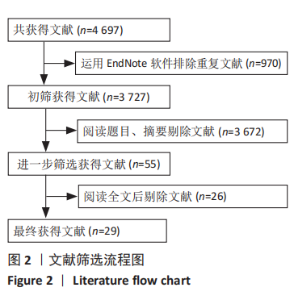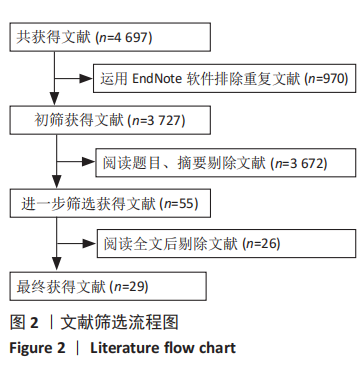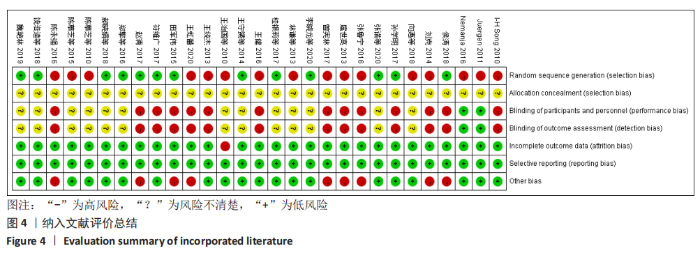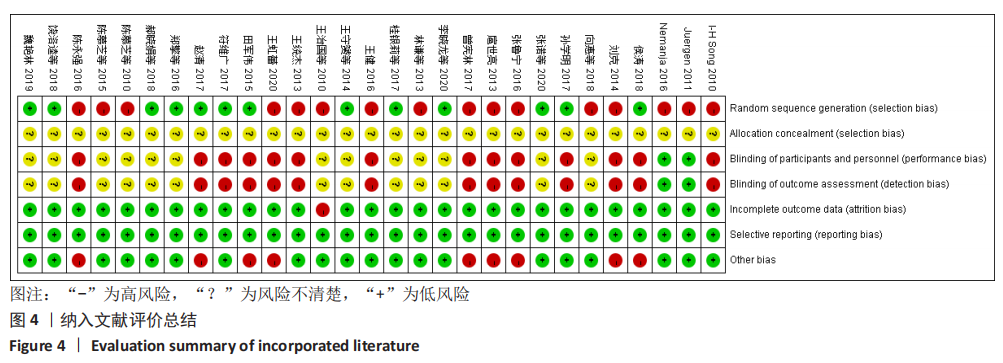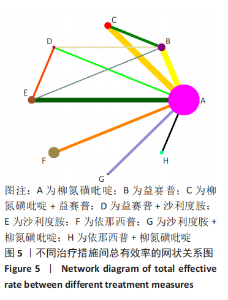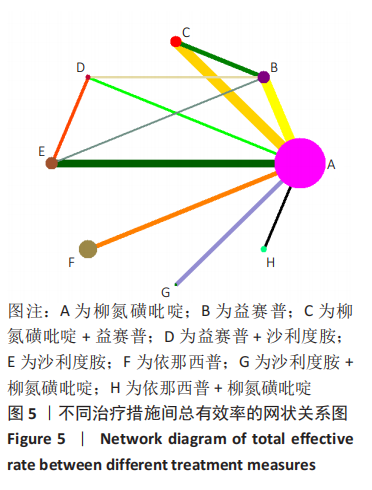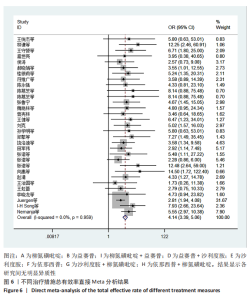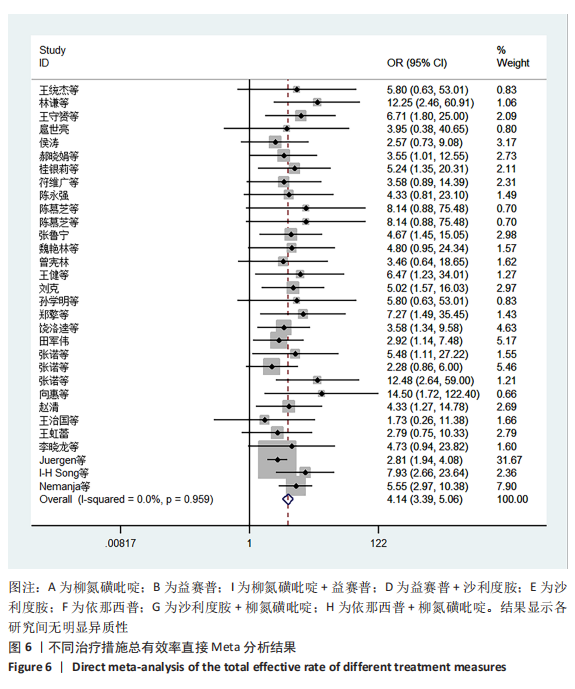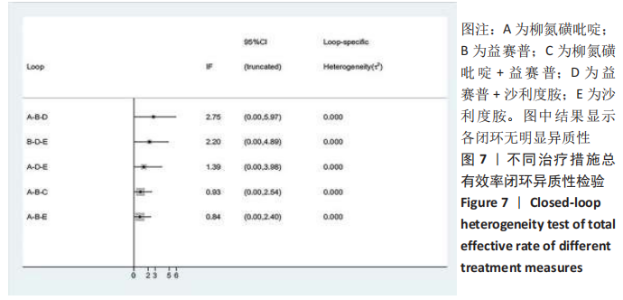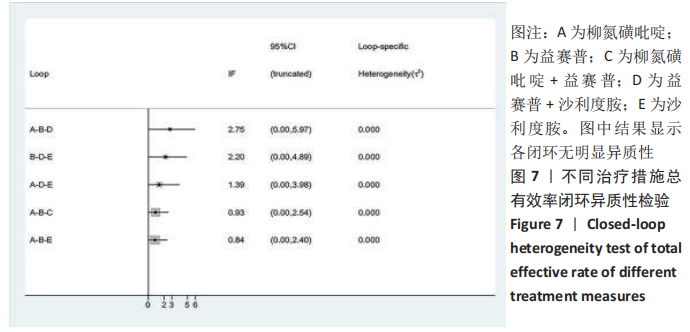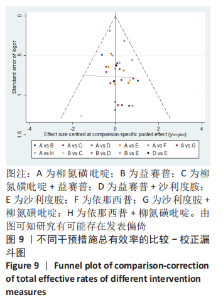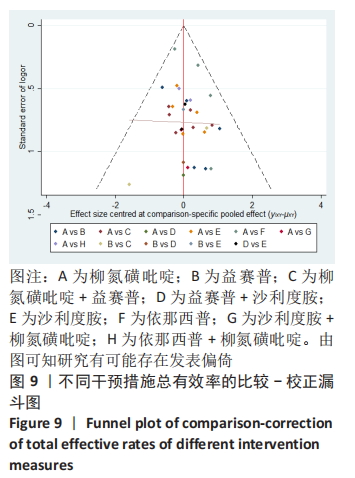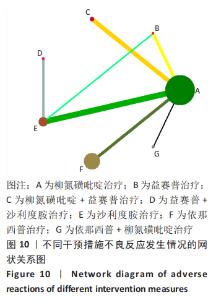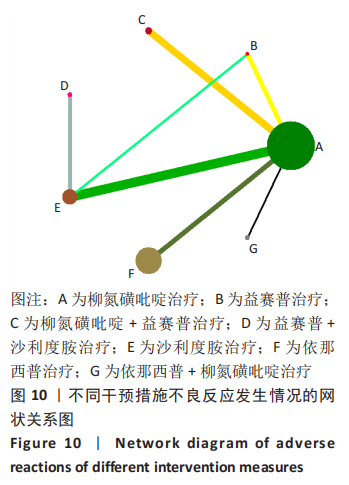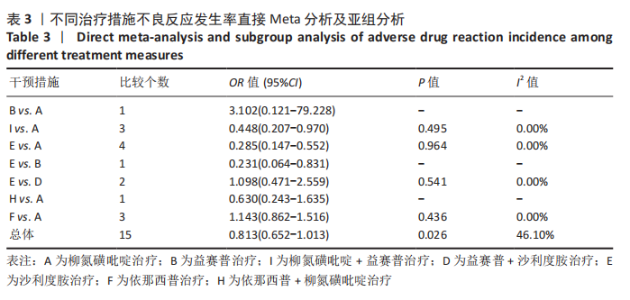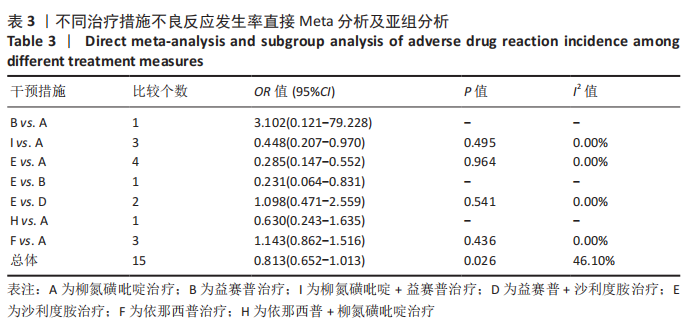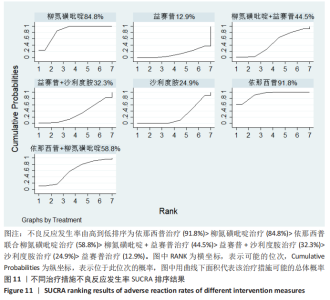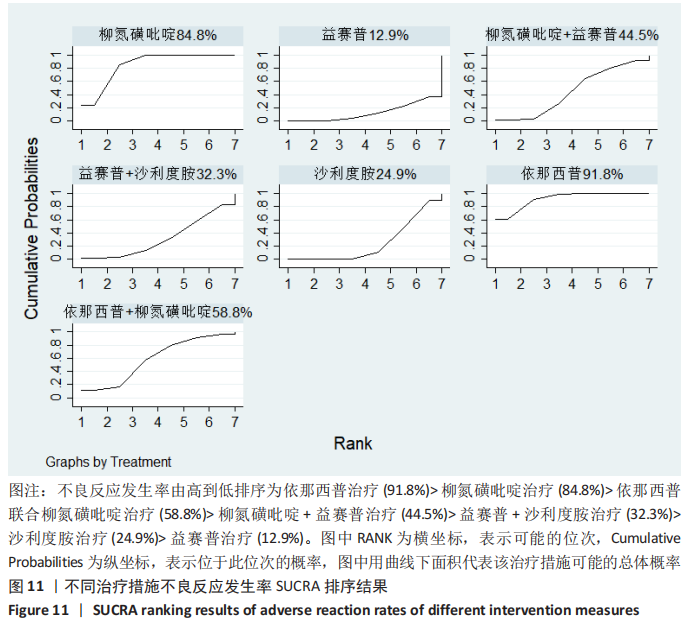Chinese Journal of Tissue Engineering Research ›› 2021, Vol. 25 ›› Issue (33): 5404-5412.doi: 10.12307/2021.334
Network meta-analysis of different drugs for the treatment of ankylosing spondylitis
Jia Hongsheng1, Li Xianlin2, Cai Lei1, Zhang Chongfeng1, Chen Zuchuang1, Zhang Ye1
- 1Henan University of Chinese Medicine, Zhengzhou 450000, Henan Province, China; 2Department of Orthopedics and Traumatology, First Affiliated Hospital of Henan University of Chinese Medicine, Zhengzhou 450000, Henan Province, China
-
Received:2021-01-07Revised:2021-01-08Accepted:2021-02-07Online:2021-11-28Published:2021-08-06 -
Contact:Li Xianlin, Chief physician, Master’s supervisor, Department of Orthopedics and Traumatology, First Affiliated Hospital of Henan University of Chinese Medicine, Zhengzhou 450000, Henan Province, China -
About author:Jia Hongsheng, Master candidate, Henan University of Chinese Medicine, Zhengzhou 450000, Henan Province, China
CLC Number:
Cite this article
Jia Hongsheng, Li Xianlin, Cai Lei, Zhang Chongfeng, Chen Zuchuang, Zhang Ye. Network meta-analysis of different drugs for the treatment of ankylosing spondylitis[J]. Chinese Journal of Tissue Engineering Research, 2021, 25(33): 5404-5412.
share this article
Add to citation manager EndNote|Reference Manager|ProCite|BibTeX|RefWorks
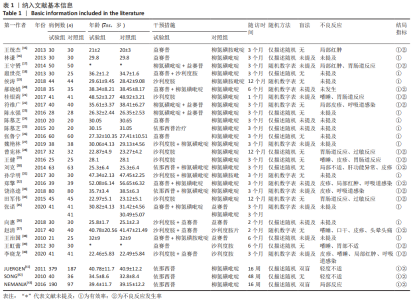
2.2 纳入文献基本特征及质量评价结果 纳入的文献基本特征见表1,纳入的29篇文献均为随机对照试验[15-43],其中有21篇文献被评价为高风险[15-16,18-19,22-26,28-31,34,36-39,41-43],8篇文献被评价为低风险[17,20-21,27,32-33,35,40]。评价的依据体现在:纳入的29篇文献中有13篇提及具体分配方法(随机数字表法)[17,19-22,27,31-35,37,40],16篇仅提及随机[15-16,18,23-26,28-30,36,38-39,41-43],未描述具体方法,关于分配隐藏均未描述;盲法方面14篇未使用盲法[15,18-19,22-23,26,28-30,34,37,39-40,42],13篇未提及[16-17,20-21,24-25,27,31-33,35-36,38],仅2篇文献明确使用双盲[41,43];纳入的29篇文献中有2篇提及病例脱落[38,41],并描述了详细原因,其他数据均完整。纳入的29篇文献,有3篇明确说明进行了临床试验注册[41-43],其他文献均未提及。结果图采用RevMan 5.3软件绘制,见图3,4。"

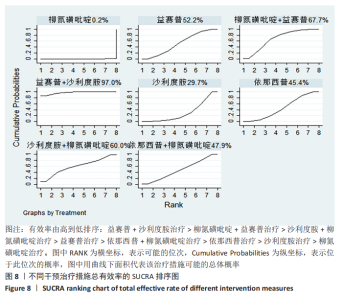
与单纯益赛普治疗相比,除益赛普+沙利度胺治疗可提高临床疗效外 (P < 0.05),其他治疗措施间均无显著差异(P > 0.05)。与柳氮磺吡啶+益赛普治疗相比,其他治疗措施间疗效无显著差异(P > 0.05)。与益赛普+沙利度胺治疗相比,沙利度胺联合柳氮磺吡啶治疗与其治疗效果无显著差异(P > 0.05),沙利度胺治疗、依那西普治疗及依那西普+柳氮磺吡啶治疗疗效较差,且沙利度胺治疗、依那西普治疗与依那西普+柳氮磺吡啶治疗疗效无显著差异(P > 0.05)。与沙利度胺治疗相比,依那西普治疗、沙利度胺联合柳氮磺吡啶治疗以及依那西普联合柳氮磺吡啶治疗效果差异无显著性意义(P > 0.05)。 2.3.4 不同治疗措施总有效率网状Meta分析排序结果 运用贝叶斯理论MCMC方法,采用固定效应模型进行网状Meta分析排序结果显示:益赛普+沙利度胺治疗(97.0%)>柳氮磺吡啶+益赛普治疗(67.7%)>沙利度胺+ 柳氮磺吡啶治疗(60.0%)>益赛普治疗(52.2%)>依那西普+柳氮磺吡啶治疗(47.9%)>依那西普治疗(45.4%)>沙利度胺治疗(29.7%)>柳氮磺吡啶治疗(0.2%),见图8。"
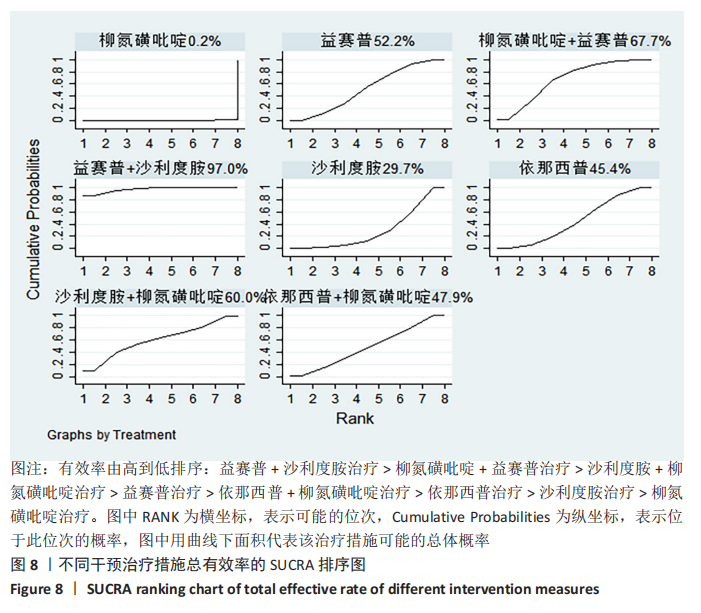

2.4.3 不同治疗措施不良反应发生率网状Meta分析结果 由表4可知,与单纯柳氮磺吡啶治疗相比,益赛普治疗和沙利度胺治疗可降低不良反应的发生 (P < 0.05),柳氮磺吡啶+益赛普治疗、益赛普+沙利度胺治疗、依那西普治疗、依那西普+柳氮磺吡啶治疗均不能有效降低不良反应发生率(P > 0.05)。与单纯益赛普治疗不良反应发生相比,依那西普治疗降低不良反应发生率疗效较差,其他治疗措施均不能有效降低不良反应发生情况(P < 0.05)。与柳氮磺吡啶联合益赛普治疗相比,依那西普治疗降低不良反应发生率疗效较差,益赛普联合沙利度胺治疗、沙利度胺治疗、依那西普联合柳氮磺吡啶治疗均不能有效降低不良反应发生率(P < 0.05)。与益赛普联合沙利度胺治疗相比,依那西普治疗降低不良反应发生率疗效较差,沙利度胺治疗和依那西普联合柳氮磺吡啶治疗均不能有效降低不良反应发生率。与沙利度胺治疗相比,依那西普治疗降低不良反应发生率疗效较差,依那西普联合柳氮磺吡啶治疗不能有效降低不良反应发生率,同时依那西普治疗与依那西普联合柳氮磺吡啶治疗降低不良反应发生率无显著差异。"

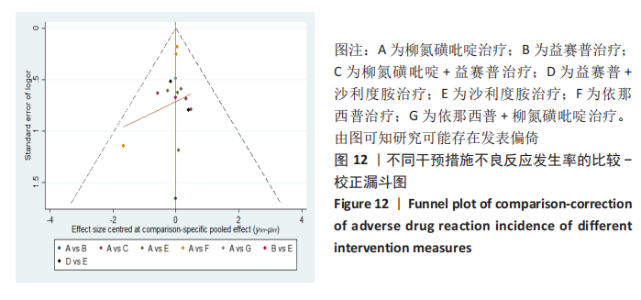
2.4.5 不同治疗措施不良反应发生率的发表偏倚分析 发表偏倚检测比较-校正漏斗图,见图12。由图可见漏斗图对称性欠佳,说明研究可能存在发表偏倚。 2.5 临床注册对不同治疗措施总有效率及不良反应发生率的影响 纳入的29项研究中有3项英文研究进行了临床注册[41-43],均在北美临床试验注册中心数据库进行了注册。 总有效率:经对比发现在总有效率排序结果上有明显的变化,在网状证据图、异质性、网状Meta分析结果以及发表偏倚检测中未见明显异常。无临床注册的排序结果显示:益赛普+ 沙利度胺治疗(93.2%)>依那西普治疗(68.5%) >柳氮磺吡啶+益赛普治疗(61.8%) >沙利度胺+柳氮磺吡啶治疗(56.0%)>益赛普治疗(47.2%)>依那西 普+柳氮磺吡啶治疗(43.6%)>沙利度胺治疗(28.2%)>柳氮磺吡啶治疗(0.5%);有临床注册的研究结果显示:益赛普+沙利度胺治疗(97.0%)>柳氮磺吡啶+益赛普治疗(67.7%)>沙利度胺+柳氮磺吡啶治疗(60.0%)>益赛普治疗(52.2%)>依那西普+柳氮磺吡啶治疗(47.9%)>依那西普治疗(45.4%)>沙利度胺治疗(29.7%)>柳氮磺吡啶治疗(0.2%)。临床注册研究均为柳氮磺吡啶治疗与依那西普治疗的对比研究,增加了样本量,补充了更加可信的临床证据,使依那西普治疗的有效率排序发生了更加可靠的变化。 不良反应发生率:经对比,发现在网状证据图增加了依那西普治疗与柳氮磺吡啶治疗的比较,在异质性检验及发表偏倚检测中未发现明显变化,在网状Meta分析结果中增加了依那西普治疗与其他药物不良反应发生率的比较,在排序结果上有明显变化。无临床注册的研究排序结果:依那西普联合柳氮磺吡啶治疗(92.1%)>柳氮磺吡啶治疗(82.9%)>柳氮磺吡啶+ 益赛普治疗(44.4%)> 益赛普+沙利度胺治疗(33.9%)>沙利度胺治疗(28.3%)>益赛普治疗(18.4%);有临床注册的研究排序结果:依那西普治疗(91.8%)>柳氮磺吡啶治疗(84.8%)>依那西普联合柳氮磺吡啶治疗(58.8%)>柳氮磺吡啶+益赛普治疗(44.5%)>益赛普+沙利度胺治疗(32.3%)>沙利度胺治疗(24.9%)>益赛普治疗(12.9%)。由于临床注册的研究均为依那西普治疗与柳氮磺吡啶治疗的对比,增加了更加可靠的临床数据及证据,使依那西普治疗、柳氮磺吡啶治疗与依那西普联合柳氮磺吡啶治疗的不良反应发生率排序结果发生了变化,可见临床注册研究结果可靠,排序结果更加准确。 "
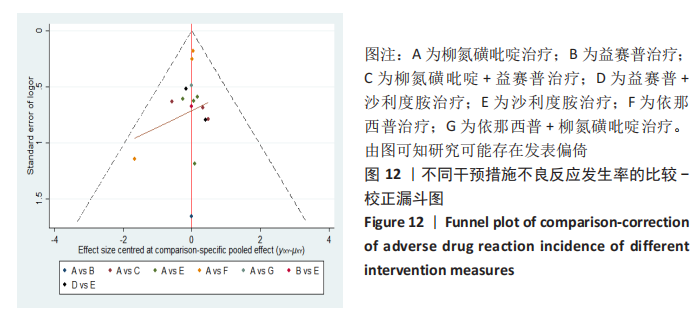
| [1] 王勤俭,王燕.苁蓉独活散联合温针灸治疗肾阳亏虚型强直性脊柱炎的临床观察[J].中国实验方剂学杂志,2020,26(12):126-132. [2] 孙学明,刘磊,曹君君,等.沙利度胺联合柳氮磺吡啶治疗强直性脊柱炎的疗效观察[J].药物评价研究,2017,40(10):1477-1480. [3] 罗绮雯,陈国强,张红卫,等.依那西普注射剂联合雷公藤多苷片治疗强直性脊柱炎的临床研究[J].中国临床药理学杂志,2019, 35(15):1578-1580. [4] BECCIOLINI A, BIGGIOGGERO M, FAVALLI EG. The role of methotrexate as combination therapy with etanerce in rheumatoid arthritis:retrospective analysis of a local registry. J Int Med Res. 2016;44(1 Suppl):113-118. [5] 谢等花.强直性脊柱炎患者接受沙利度胺治疗的效果探讨[J].基层医学论坛,2020, 24(17):2405-2406. [6] 李朝霞,曾珊,吴会霞,等.沙利度胺治疗强直性脊柱炎的安全性Meta分析[J].今日药学,2019,29(6):420-426. [7] 张笑,罗晓舟,曹秋雨,等.针灸与柳氮磺胺吡啶治疗强直性脊柱炎有效性的网状Meta分析[J].中华中医药学刊,2018,36(10): 2321-2324. [8] 刘志燕,柳芳,李朋梅,等.白芍总苷胶囊联合柳氮磺吡啶片对比柳氮磺吡啶片治疗强直性脊柱炎的疗效和安全性的Meta分析[J].中国药房,2018,29(17):2416-2420. [9] 邢伟鹏,李无阴,侯宏理,等.沙利度胺治疗强直性脊柱炎疗效的Meta分析[J].中国药房,2018,29(1):116-120. [10] 李晓群,李靖,都建苹.益赛普联合传统抗风湿药物治疗强直性脊柱炎的Meta分析[J].黑龙江医学,2018,42(1):93-96. [11] 刘永军,戎红波.英夫利昔单抗治疗强直性脊柱炎疗效与安全性的Meta分析[J].中国新药与临床杂志,2016,35(11):815-821. [12] 翟佳羽,吕青,赵敏菁,等.甲氨蝶呤和柳氮磺吡啶治疗强直性脊柱炎安全性和有效性的Meta分析[J].中山大学学报(医学科学版),2015,36(1):42-54. [13] 侯东杰,王建民.益赛普与柳氮磺胺吡啶治疗强直性脊柱炎的Mete分析[J].宁夏医科大学学报,2014,36(5):545-552. [14] VAN DER LINDEN S, VALKENBURG HA, CATS A. Evaluation of diagnostic criteria for ankylosing spondylitis. A proposal for modification of the New York criteria. Arthritis Rheum. 1984;27(4): 361-368. [15] 王统杰,王海琨.两种方法治疗活动期强直性脊柱炎的疗效比较[J].中国医药指南, 2013,11(27):205-207. [16] 林谦,伍俊妍.注射用重组人Ⅱ型肿瘤坏死因子受体-抗体融合蛋白治疗强直性脊柱炎60例的临床观察[J].中国当代医药,2013, 20(21):87-88. [17] 王守赟,阮文礼,宋子缨.注射用重组人Ⅱ型肿瘤坏死因子受体-抗体融合蛋白联合柳氮磺吡啶治疗强直性脊柱炎的临床观察[J].中国医院用药评价与分析,2014,14(12): 1083-1085. [18] 扈世亮.益赛普联合沙利度胺用于难治性强直性脊柱炎的疗效研究[J].中国医学创新, 2013,10(22):32-33. [19] 侯涛.沙利度胺治疗强直性脊柱炎的效果分析[J].河南医学研究,2018,27(4):662-663. [20] 郝晓娟,赵花妮,张强,等.注射用重组Ⅱ型肿瘤坏死因子受体抗体融合蛋白联合柳氮磺吡啶治疗活动性强直性脊柱炎的疗效[J].临床医学研究与实践,2018,3(17):16-17. [21] 桂银莉,史丽璞,郇稳,等.沙利度胺治疗强直性脊柱炎有效性与安全性的观察[J].现代诊断与治疗,2017,28(18):3382-3384. [22] 符维广,李浩鹏.重组人Ⅱ型肿瘤坏死因子受体-抗体融合蛋白治疗强直性脊柱炎的临床效果[J].中国医药导报,2017,14(6):112-115. [23] 陈永强.益赛普组合柳氮磺吡啶在强直性脊柱炎中的疗效观察[J].北方药学,2016, 13(11):11-12. [24] 陈慕芝,照日格图,王海云,等.重组人Ⅱ型肿瘤坏死因子受体-抗体融合蛋白与传统免疫抑制剂治疗强直性脊柱炎的临床对照研究[J].新疆医科大学学报,2010,33(8):913-915. [25] 陈慕芝,孙学斌,段红妍.依那西普与柳氮磺吡啶治疗强直性脊柱炎的效果[J].中国医药导报,2015,12(7):82-85. [26] 张鲁宁.益赛普治疗难治性强直性脊柱炎患者的疗效观察[J].中国民康医学,2016, 28(10):34-35. [27] 魏艳林,夏楠楠,张伟峰,等.沙利度胺联合柳氮磺吡啶对强直性脊柱炎患者炎性反应的影响[J].临床医学工程,2019,26(7):957-958. [28] 曾宪林.沙利度胺治疗强直性脊柱炎的长期疗效与安全性分析[J].齐齐哈尔医学院学报,2017,38(20):2412-2414. [29] 王健,吉健华,王医林,等.沙利度胺与柳氮磺吡啶治疗强直性脊柱炎效果比较观察[J].人民军医,2016,59(1):45-47. [30] 刘克.依那西普联合柳氮磺吡啶治疗强直性脊柱炎的临床疗效[J].中国医药指南,2014, 12(36):217-218. [31] 孙学明,刘磊,曹君君,等.沙利度胺联合柳氮磺吡啶治疗强直性脊柱炎的疗效观察[J].药物评价研究,2017,40(10):1477-1480. [32] 郑擎,徐鸣俊.重组人Ⅱ型肿瘤坏死因子受体抗体融合蛋白治疗强直性脊柱炎的临床研究[J].中国临床药理学杂志,2016,32(17): 1561-1564. [33] 饶洛逵,陆熙宴.依那西普联合柳氮磺吡啶治疗强直性脊柱炎的疗效及安全性[J].中国医院用药评价与分析,2018,18(3):351-353. [34] 田军伟.沙利度胺治疗强直性脊柱炎临床效果观察[J].河南医学研究,2015,24(9):43-45. [35] 张诺,郭明蔚,陈桂武,等.益赛普联合柳氮磺吡啶治疗强直性脊柱炎疗效及miR-29a、miR-146a的变化[J].分子诊断与治疗杂志,2020,12(5):587-591. [36] 向惠,衡明强.沙利度胺联合注射用重组人Ⅱ型肿瘤坏死因子受体-抗体融合蛋白对难治性强直性脊柱炎的治疗效果[J].中国继续医学教育,2018,10(19):127-128. [37] 赵清.益赛普联合沙利度胺治疗难治性强直性脊柱炎临床研究[J].中国药业,2017,26(9): 47-49. [38] 王治国,佟胜全,饶莉,等.短期益赛普联合柳氮磺胺吡啶治疗强直性脊柱炎的疗效研究[J].实用临床医药杂志,2010,14(7):65-66. [39] 王虹蕾.益赛普治疗强直性脊柱炎的疗效[J].中国实用医刊,2012,39(15):122. [40] 李晓龙,苏振炎,张益宏,等.注射用重组人Ⅱ型肿瘤坏死因子受体-抗体融合蛋白联合沙利度胺对强直性脊柱炎患者血清炎性因子的影响[J].颈腰痛杂志,2020,41(3):321-324. [41] BRAUN J, VAN DER HORST-BRUINSMA IE, HUANG F, et al. Clinical efficacy and safety of etanercept versus sulfasalazine in patients with ankylosing spondylitis: a randomized, double-blind trial. Arthritis Rheum. 2011;63(6):1543-1551. [42] SONG IH, HERMANN KG, HAIBEL H, et al. Relationship between active inflammatory lesions in the spine and sacroiliac joints and new development of chronic lesions on whole-body MRI in early axial spondyloarthritis: results of the ESTHER trial at week 48. Ann Rheum Dis. 2011;70(7):1257-1263. [43] DAMJANOV N, SHEHHI WA, HUANG F, et al. Assessment of clinical efficacy and safety in a randomized double-blind study of etanercept and sulfasalazine in patients with ankylosing spondylitis from Eastern/Central Europe, Latin America, and Asia. 2016;36(5):643-651. [44] SCHULZ M, DOTZLAW H, NEECK G. Ankylosing spon-dylitis and rheumatoid arthritis: serum levels of TNF-αand its soluble receptors during the course of therapy withetanercept and infliximab. Biomed Res Int. 2014;2014:675108. [45] 石向慧,纪禄风,陈蓓蓓,等.白细胞介素-6在强直性脊柱炎诊治中的研究现状[J].风湿病与关节炎,2017,6(4):65-69. [46] PARHAM C, CHIRICA M, TIMANS J, et al. A receptor for the heterodimeric cytokine IL-23 is composed of IL-12Rbeta1 and a novel cytokine receptor subunit, IL-23R. J Immunol. 2002;168(11):5699-5708. [47] 曹芳,汪悦.中医健脾法与IL-23/Th17/IL-17通路在强直性脊柱炎中的研究进展[J].辽宁中医杂志,2017,44(3):662-665. [48] 王星,张莹,郑军,等.TNF-α拮抗剂治疗早期强直性脊柱炎临床效果观察[J].西南国防医药,2019,29(12):1200-1203. [49] CHOUDHURY MR, HASSAN MM, KABIR ME, et al. An open label clinical trial of Thalidomide in NSAIDs refractory ankylosing spondylitis. Mod Rheumatol. 2018;28(4):730-732. [50] 吕艳霞.沙利度胺联合重组人肿瘤坏死因子受体-抗体融合蛋白治疗强直性脊柱炎50例临床观察[J].中国药物与临床,2014, 14(12):1712-1713. [51] 陈伟伦,姚翠霞,林永明.沙利度胺联合益赛普治疗难治性强直性脊柱炎临床探析[J].中国医药科学,2013,24(2):92-93. [52] VAN DARTEL SA, FRANSEN J, KIEVIT W, et al. Difference in the risk of serious infections in patients with rheumatoid arthritis treated with adalimumab, infliximab and etanercept:results from the Dutch Rheumatoid Arthritis Monitoring (DREAM) registry. Ann Rheum Dis. 2013;72(6):895-900. [53] ALI T, KAITHA S, MAHMOOD S, et al. Clinical use of anti-TNF therapy and increased risk of infections. Drug Healthc Patient Saf. 2013;5:79-99. [54] NAVARRA S V, TANG B, LU L, et al. Risk of tuberculosis with anti-tumor necrosis factor-α therapy: substantially higher number of patients at risk in Asia. Int J Rheum Dis. 2014; 17(3):291-298. [55] DREYER L, MELLEMKJæ RL, ANDERSEN AR, et al. Incidences of overall and site specific cancers in TNFα inhibitor treated patients with rheumatoid arthritis and other arthritides-a follow-up study from the DANBIO Registry. Ann Rheum Dis. 2013;72(1):79-82. [56] 汪洋,马民玉.风湿祛痛胶囊联合柳氮磺吡啶治疗强直性脊柱炎的临床研究[J].现代药物与临床,2020,35(10):2002-2005. [57] HAROON N, INMAN RD, LEARCH TJ, et al. The impact of tumor necrosis factorαinhibitors on radiographic progression in ankylosing spondylitis. Arthritis Rheum. 2013;65:2645-2654. [58] 陈庆花,杨永红,邱悦群,等.益赛普治疗强直性脊柱炎有效性和安全性临床对比研究[J].中国疼痛医学杂志,2011,17(12):760-761. [59] 刘维,张迪,吴沅皞,等.中药联合重组人Ⅱ型肿瘤坏死因子受体-抗体融合蛋白治疗强直性脊柱炎疗效观察[J].中国中西医结合杂志,2016,36(6):663-667. [60] 胡久丽,朱孝芹,肖旭,等.沙利度胺致严重药品不良反应2例[J].中国现代应用药学, 2019,36(18):2334-2335. [61] 陈锦敏,柳鹏程,余正.美国FDA药品上市后风险管理措施研究及对我国的启示-以沙利度胺为例[J].中国新药杂志,2020,29(23): 2654-2659. (责任编辑:WJ,ZN,ZH) |
| [1] | Zhang Feng. Long-term effects and adverse events of polyetheretherketone versus titanium mesh materials in repairing skull defects: a prospective, single-center, non-randomized controlled, 2-year follow-up clinical trial protocol [J]. Chinese Journal of Tissue Engineering Research, 2021, 25(34): 5501-5505. |
| [2] | Huang Cihui, Liu Jiayue, Huang Yingjie, Zhuang Zeqin, Lin Yunxin, Li Dan, Zheng Liang. Clinical efficacy of small needle knife combined with traditional Chinese medicine in the treatment of knee osteoarthritis: a network Meta-analysis [J]. Chinese Journal of Tissue Engineering Research, 2021, 25(32): 5240-5248. |
| [3] | Yuan Jiaqin, Luan Fujun, Chen Yangfan, Li Bo. Efficacy of anterograde and retrograde intramedullary nails in the treatment of distal femoral extraarticular fracture: a meta-analysis [J]. Chinese Journal of Tissue Engineering Research, 2021, 25(30): 4915-4920. |
| [4] | Xie Jiang, Dai Jie, Li Hui, Zhu Xu. Biomechanical analysis of sagittal balance restoration of ankylosing kyphosis based on pelvic sagittal parameters [J]. Chinese Journal of Tissue Engineering Research, 2021, 25(30): 4762-4766. |
| [5] | Zhong Liqing, Zhong Shanshan, Han Weichao, Hu Runkai, He Shufen, Ding Shaobo. Systematic review of the efficacy and safety of umbilical cord-derived cell transplantation for patients with cerebral palsy [J]. Chinese Journal of Tissue Engineering Research, 2021, 25(25): 4095-4100. |
| [6] | Xu Weilong, Zuo Yuan, Xin Daqi, He Chenyang, Zhao Peng, Shi Ming, Zhou Boyuan, Liu Yating, Zhao Yan. Selection of modeling methods for acute compressive spinal cord injury: a network Meta-analysis [J]. Chinese Journal of Tissue Engineering Research, 2021, 25(23): 3767-3772. |
| [7] | Zhang Chongfeng, Li Xianlin, Peng Weibing, Jia Hongsheng, Cai Lei. Treating lumbar disc herniation of blood stasis type with Chinese herbs, acupuncture, moxibustion, and massage: a Bayesian network Meta-analysis [J]. Chinese Journal of Tissue Engineering Research, 2021, 25(17): 2781-2788. |
| [8] | Geng Zhizhong, Pei Ziwen, Yan Gongli, Chen Jian. A meta-analysis of kinesio taping in the treatment of delayed onset muscle soreness [J]. Chinese Journal of Tissue Engineering Research, 2020, 24(35): 5733-5740. |
| [9] | Feng Fan, Cai Yi, Li Yingbo, Dong Junli, Wu Qun, Fan Yongzhi, Yan Hong. Comparison of seven surgical interventions for lumbar disc herniation: a network meta-analysis#br# [J]. Chinese Journal of Tissue Engineering Research, 2020, 24(3): 453-459. |
| [10] | Xiang Xi, Si Qunchao, Cheng Weiyi, Cao Ping, Zheng Jinpeng, Hu Bing. A network meta-analysis of different surgical methods in the treatment of lumbar disc herniation [J]. Chinese Journal of Tissue Engineering Research, 2020, 24(27): 4398-4405. |
| [11] | Shi Yuling, Li Guangyao, Liang Zujian. Various acupuncture therapies for lateral epicondylitis: a Bayesian network meta-analysis [J]. Chinese Journal of Tissue Engineering Research, 2020, 24(23): 3756-3763. |
| [12] | Ma Xin, Zhang Wenhui, Yang Yuping, Yuan Zhiguo. Meta-analysis of barbed suture versus traditional suture in primary total knee arthroplasty [J]. Chinese Journal of Tissue Engineering Research, 2020, 24(21): 3430-3437. |
| [13] | Cen Zhuohao, Chen Jiena, Huang Jiahua, Shi Chushuo, Zhou Chi, Wen Junmao, Ling Min. Acupuncture combined with other therapies for osteoporosis: a network meta-analysis [J]. Chinese Journal of Tissue Engineering Research, 2020, 24(2): 320-328. |
| [14] | Zhang Jinhuan, Chen Yirong, Lan Kai, Hu Liyu, Yu Haibo. Network meta-analysis on effectiveness of fire needle, warm acupuncture, and electroacupuncture in the treatment of knee osteoarthritis [J]. Chinese Journal of Tissue Engineering Research, 2020, 24(18): 2945-2952. |
| [15] | Huang Ruina, Huang Ruijia, Niu Caili, Wen Junmao, Liu Wanjun, Han Hui, Tian Ting, Wu Xiaowan. Network Meta-analysis of five common dressings in the treatment of pressure ulcer [J]. Chinese Journal of Tissue Engineering Research, 2020, 24(16): 2614-2619. |
| Viewed | ||||||
|
Full text |
|
|||||
|
Abstract |
|
|||||
